NIL
College football fans upset by CFP, transfer portal losing faith
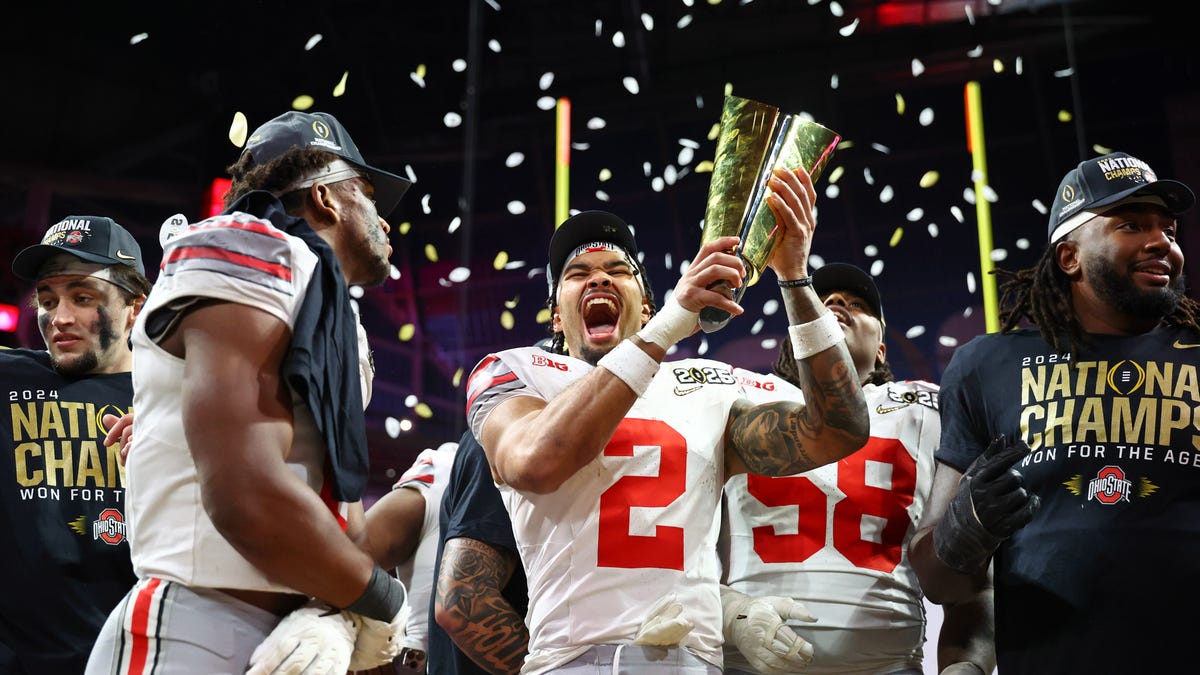
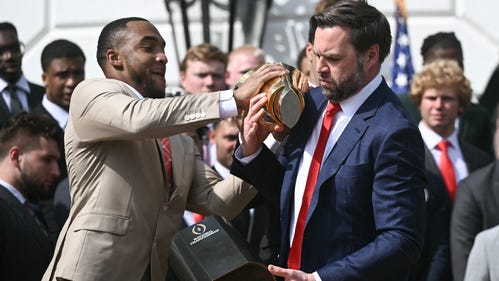
JD Vance fumbles Ohio State title trophy at White House event
Ryan Day and the Ohio State Buckeye’s football team were honored at the White House for their 2024 national championship victory.
They may as well have rolled out Quantum mechanics at this point. The attention span in this legal fight has flatlined for Joe Sixpack.
And that’s exactly what they want.
But before those running college sports – do we really know who they are at this point? – get comfortable with their shrewd shell game in the unfolding House settlement case impacting college football, understand this: no one in the history of business has survived by ignoring who they serve.
And with each passing month over the last four torturous years of paradigm change, those running college sports are on the edge of a catastrophic misread.
The fans, who fuel their collective sports, can only take so much.
So while attorneys for the NCAA and players fight it out in court over billions in lost revenue and billions more in future revenue, the fans – the one constant that has grown college football to unthinkable heights – have had a bellyful.
They’ve tuned out the monetary fight. They don’t care about billions made annually by Football Bowl Subdivision programs (some much more than others) and don’t give a rip how it’s split.
They don’t care about roster size and/or management, or that coaches continue to declare the loss of walk-ons is somehow, in some way, a death knell to the sport.
They just want their ball on fall Saturdays.
They want to roll into town Friday night, reconnect and avoid the grind of life, and hope like all hell this is the season they finally beat State. Simple, easy stuff.
But the flood of structural moves over the last four years – most made with zero foresight into how it impacts the product being sold – is now bleeding into their beautiful symphony of an escape. Tailgates and touchdowns have ben interrupted by lengthy litigation
Before we go further, this must be said: a majority of fans don’t care about money. It’s a titillating point of argument within the sport of arguing.
Our team is better than yours. Our conference is better than yours. Our band is better than yours.
And now, our quarterback makes less than your quarterback, and wins more games.
That’s it.
What does matter is player movement. What could lead to fans backing away from college football and not spending billions on the No. 2 sport in the country (behind only the NFL), is free player movement every single season.
They’ll put-up with a lot, these generational fans. An ever-changing postseason that morphed from media choosing a champion, to computer dorks and something called the Harris poll choosing it.
To a four-team playoff, and now a 12-team playoff, and what looks like at least at 14- or 16-team playoff beginning in 2026. They put up with Indiana and SMU being selected in the College Football Playoff, for the love of all things pigskin.
But players moving freely from team to team at an alarming rate, and the idea of school pride and loyalty dying at a similar rate, is where they may begin to draw the line.
The connection with fans and universities and school pride goes beyond school colors. It’s the development of players and coaches, and the investment of a three- or four-year journey of growing with your school.
It may sound hokey and contrived, but those at the top making decisions in the name of the NCAA better sit up and take notice. Because when you’re asking those you serve to spend more money on seat licenses and tickets, on apparel and flights and hotel rooms and rental cars and tailgating and everything else that goes into seven or eight home games every year, there will be hesitation.
Do you spend and invest time in a product that doesn’t align with what’s important to you, or do you sit home in your comfortable living room, with your own clean bathroom, and – here’s the key – when the game is over, you switch off your 70-inch television and a few minutes later, you’re on to the next thing.
Not sitting in traffic for the next four hours.
This isn’t that difficult. Figure out a financing plan that pays players their value, and then add hefty buyouts to all player contracts. That’s not collusion, that’s business.
If it were collusion, coaches could’ve argued it and won in court decades ago. They didn’t because it’s a legally sound move.
And if you want to keep your lower Bowl Subdivision schools from dying, force power conference schools to pay a premium talent fee to sign a player from Group of Five schools. They developed the players, they should be compensated.
University presidents have instead sent attorneys to argue semantics while bickering over billions, and sent conference commissioners to swanky hotels to bicker over a playoff.
Meanwhile, the DNA of the sport – its loyal and passionate fans – are minimized and marginalized.
And they can only take so much.
Matt Hayes is the senior national college football witer for USA TODAY Sports Network. Follow him on X at @MattHayesCFB.
NIL
Why the NIL era will continue to force more QB transfers
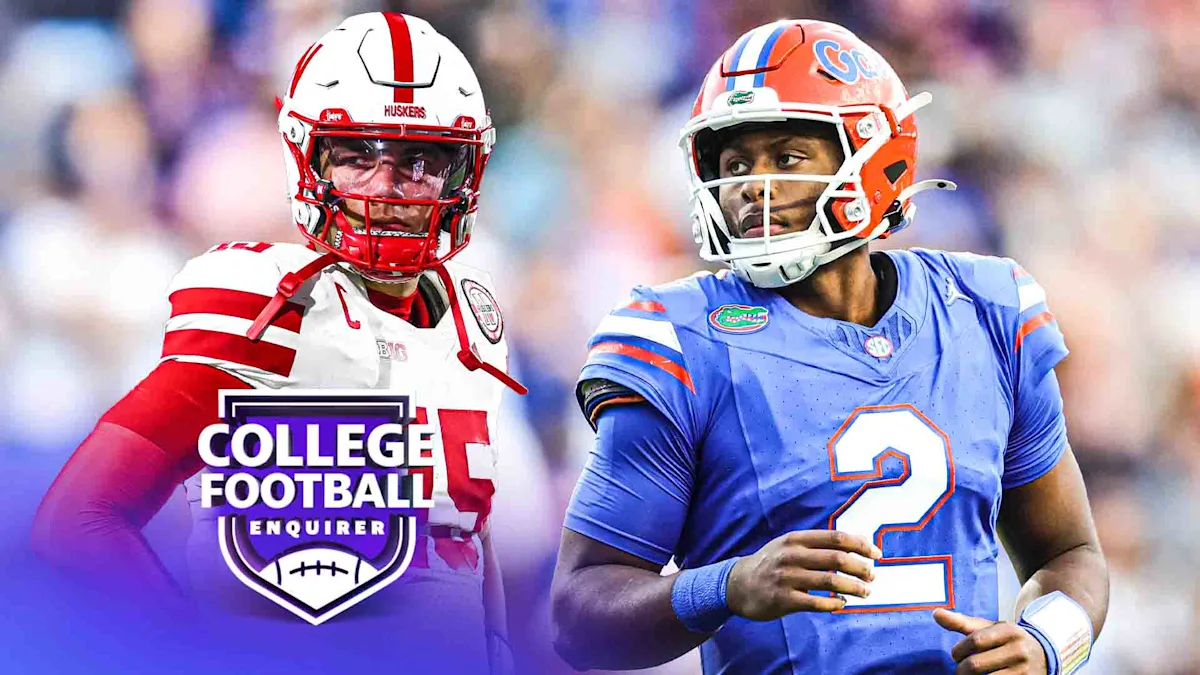
College Football Enquirer co-hosts Andy Staples, Ross Dellenger and Steven Godfrey discuss the decisions by Dylan Raiola and DJ Lagway to enter the transfer portal and why the moves are a sign of more to come when quarterbacks are paid highly but don’t meet expectations on the field. Check out the full conversation on the “College Football Enquirer” podcast – and subscribe on Apple Podcasts, Spotify, YouTube or wherever you listen.
Advertisement
Video Transcript
I do think we’re seeing something a bit different now.
And we started to see it last year, but Ross brought it up with the Royala situation.
I talked about it with the Lagway situation.
These guys are established starters.
Who, if one had a coaching change, that adds something to it, But the other didn’t have a coaching change.
But neither of them lived up to their lofty expectations or lofty paycheck, And I do the latter, right.
And I do wonder until there’s a CBA and you have binding contracts both ways.
I don’t know that we’re gonna see, like, you gonna have to really earn and kind of sing for Your supper as a QB.
Advertisement
You’re gonna have to earn it, or you’re gonna have to be drastically underpaid.
Threatened to leave, then got overpaid.
So basically, if you’re a successful quarterback in a three-year span, you’re constantly Renegotiating: correct if you’re at one institution, yes.
You’d better be good enough to justify your price point or willing to take a cut.
That is the that’s the conundrum there and you can price yourself out of market Well.
And that’s, that’s the other thing people Need to be careful.
That’s what they, you know, We talk about a truly free market, and thats kind of what This is.
This is a truly free market, but there’s always An upper boundary.
Advertisement
It’s interesting how these things are going now to be handled financially in the offseason.
If there can be any stability, um, as you are performing at or above Expectation as a quarterback, because otherwise wethis is probably going to be the norm.
We’re probably gonna have a Black Monday type situation.
Every December, in the quarterback free agency market, if we don’t get a little more guard, A little more guardrails around that, yeah, until some kind of, you know, Bargaining agreement in more binding contracts are, uh, Uh, come to college football, which doesn’t sound like it’s anytime soon, Although, because of failures in Congress, the CSC participation agreement, I think there’s more, more than not, and this is something that was a topic in Las Vegas last Week, uh, um, is, yeah, more, more talk about, Well, what other options do we have?
Advertisement
Which is really just one other option.
Remember, coaches have always cut loose QBs.
They didn’t want it.
That’s always happened.
Yeah, runoff was like a common verb when coaches talked off the record about How they were gonna handle their roster.
We’re running that guy off.
So this is, if anything, a new market that gives at least these guys a little bit of cash first They get it before they go out the door.
NIL
Ohio State QB Julian Sayin makes NIL announcement before College Football Playoff

Julian Sayin is steering Ohio State toward a national championship run with one of the most loaded rosters in college football. The Buckeyes secured the No. 2 seed in the College Football Playoff despite stumbling against Indiana in the Big Ten title game.
That loss stung, but it did not derail their season. Ohio State still earned a first-round bye alongside Indiana, Texas Tech, and Georgia.
MORE: Florida quarterback DJ Lagway announces transfer portal decision
While the team enjoyed some extra rest before the postseason grind begins, Sayin grabbed attention off the field. He announced a new NIL partnership with Wingstop and Dr Pepper, posting the news himself.
“Postseason calls for big plays with @drpepper and @wingstop, had to get the play card out,” Sayin wrote.
The deal adds to an already impressive NIL portfolio. Sayin previously signed with The Foundation, Dick’s Sporting Goods, and JLab Audio. His current NIL valuation sits at $2.5 million, according to On3.

Ohio State Buckeyes quarterback Julian Sayin talks to media following the NCAA football game against the Michigan Wolverines at Michigan Stadium in Ann Arbor, Mich. on Nov. 29, 2025. Ohio State won 27-9.
Sayin’s path to Columbus took a detour through Tuscaloosa first. After a brief stint with Alabama, he flipped his commitment to Ohio State and headed to the Big Ten. That decision paid off immediately.
In his first season as the Buckeyes’ starting quarterback, Sayin led the team to a 12-1 record and a Heisman Trophy finalist nod. The former five-star recruit has lived up to the hype.

Ohio State Buckeyes quarterback Julian Sayin (10) motions during the Big Ten Conference championship game against the Indiana Hoosiers at Lucas Oil Stadium in Indianapolis on Dec. 6, 2025. Ohio State lost 13-10.
His numbers back it up. Sayin has thrown for 3,323 yards and 31 touchdowns this season, showing both control and efficiency under center.
He is playing alongside elite talent like wide receiver Jeremiah Smith, Carnell Tate, Caleb Downs, and Arvell Reese. With that kind of firepower around him, Ohio State looks built for a deep playoff run.
— Enjoy free coverage of the top news & trending stories on The Big Lead —
NFL: Head coaches on hot seat entering Week 16 of NFL season
NFL DRAFT: Texas star Arch Manning reveals shocking 2026 NFL Draft status
CFB: Florida quarterback DJ Lagway announces transfer portal decision
NBA: Victor Wembanyama gives ultimate compliment to Oklahoma City Thunder amid rivalry talks
SPORTS MEDIA: ESPN analysts bash Dallas Cowboys defense for slim NFL playoff odds
VIRAL: DeAndre Ayton’s mom cooks incredible Jamaican holiday meal for Lakers
NIL
Ed Orgeron wants Trump ‘more involved’ in NIL regulation

NEWYou can now listen to Fox News articles!
It has been less than half a decade since Ed Orgeron was last on a football sideline, but the sport has had a generational shakeup in the NIL era.
Coach O won a national championship at LSU with, in his words, “the best transfer ever” in Joe Burrow on a team he said is “up there” among the greatest college football teams ever. But the landscape has changed so much that even President Donald Trump signed a “Saving College Sports” executive order.
What remains of Trump’s executive order is a bit of a mystery, but Orgeron wants Trump to be “more involved.”
CLICK HERE FOR MORE SPORTS COVERAGE ON FOXNEWS.COM

Ed Orgeron wants President Trump “more involved” in NIL regulation after the president called college sports a “disaster.” (Rebecca Warren/Imagn Images, Andrew Harnik/Getty Images)
“I think he should be more involved. Something has to happen. Our sport is getting killed, man,” Orgeron said in a recent interview with Fox News Digital.
“I love players getting paid. I think it’s fair. But I think there ought to be a cap, and the transfer portal, there’s got to be rules on it. It’s kind of like the Wild Wild West. I’m talking to coaches, it’s like, ‘Hey man, we’re working 24/7, 12 months a year. It’s crazy when guys are coming, when they’re going.’ But you know what? It’s got to be give and take. Players have got to get a lot, but the schools have got to get some guarantee in return…
“I think the president, he loves football, he’s a friend of mine, the more he can step in and stop what’s going on in college football, the better off it’s going to be.”
Trump recently ripped the supposed “disaster” that is NIL.
“I think that it’s a disaster for college sports. I think it’s a disaster for the Olympics, because, you know, we’re losing a lot of teams. The colleges are cutting a lot of their — they would call them sort of the ‘lesser’ sports, and they’re losing them like at numbers nobody can believe. They were really training grounds, beautiful training grounds, hard-working, wonderful young people. They were training grounds for the Olympics,” Trump said in the Oval Office last Thursday.
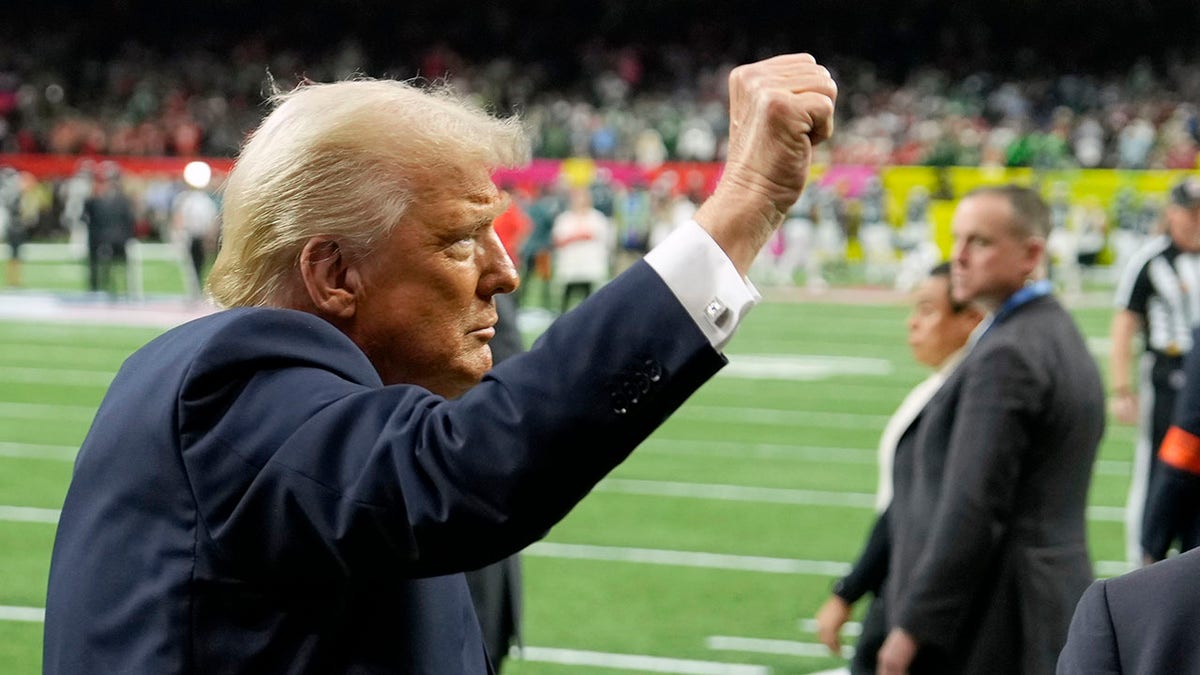
President Donald Trump gestures to the crowd before the start of the NFL Super Bowl LIX football game between the Philadelphia Eagles and the Kansas City Chiefs, Sunday, Feb. 9, 2025, in New Orleans. (AP Photo/Ben Curtis)
ARCH MANNING TO RETURN TO TEXAS FOR 2026 SEASON: REPORTS
“And a lot of these sports that were training so well would win gold medals because of it. Those sports don’t exist, because they’re putting all their money into football. And by the way, they’re putting too much money into it, into football.”
Orgeron has teamed up with player agent Tzvi Grossman to tap into the new NIL era and has learned a great deal as he tries to find his next stop in college football. But despite all the money being passed around, Orgeron still believes that one aspect of recruiting trumps all.
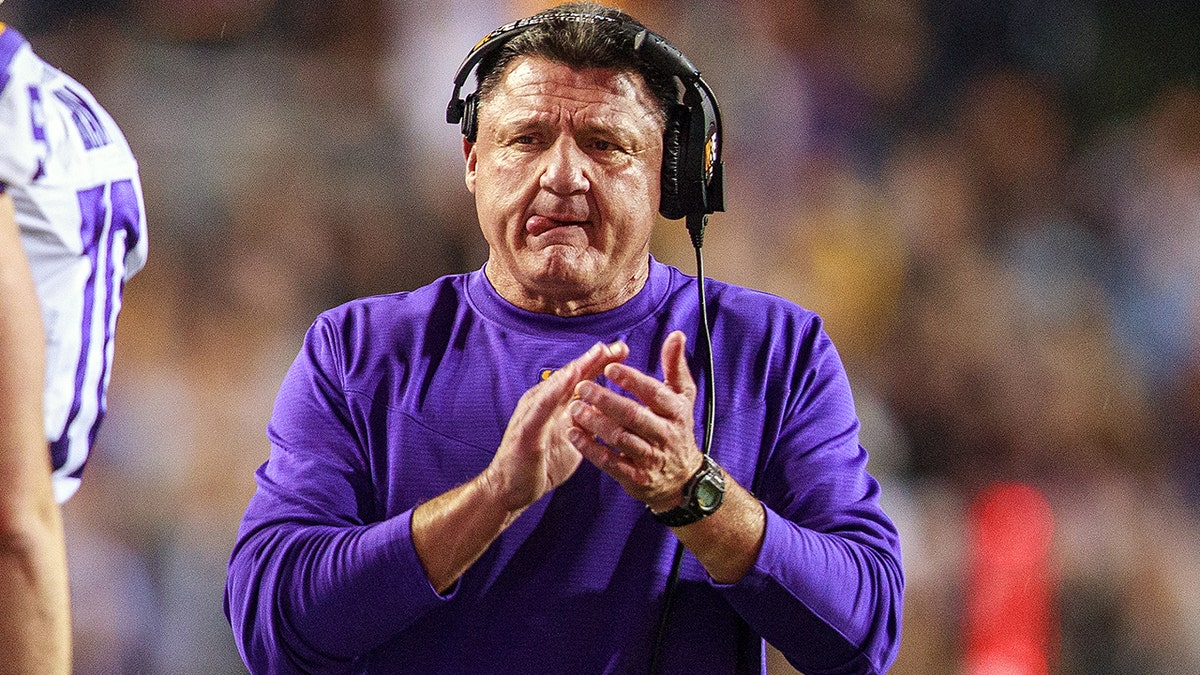
LSU Tigers head coach Ed Orgeron during a game between the Texas A&M Aggies and the LSU Tigers, in Tiger Stadium in Baton Rouge, Louisiana, on Nov. 27, 2021. (John Korduner/Icon Sportswire via Getty Images)
CLICK HERE TO GET THE FOX NEWS APP
“You still have to recruit, you still have to evaluate, you still have to get the mamas, the champions, all that to have a championship football team, and then the (key) word develop,” Orgeron said. “Just because you’re paying the guys — I believe all our players should be paid, I’m with that — but the money that they get right now is not the money that Joe Burrow’s making. It’s not the money that Ja’Marr Chase is making, Derek Stingley’s making. So in other words, to develop at the school you’re going to go to is still important.”
Follow Fox News Digital’s sports coverage on X, and subscribe to the Fox News Sports Huddle newsletter.
NIL
Ohio State QB Julian Sayin Announces NIL News Before College Football Playoff

Julian Sayin is looking to lead the Ohio State Buckeyes to the national title alongside several other stars like wide receiver Jeremiah Smith.
Ohio State heads into the College Football Playoff with one of the best rosters in the country, starring Sayin and Smith along with Carnell Tate, Caleb Downs and Arvell Reese.
They’re heading into the playoffs as the No. 2 seed after losing to Indiana in the Big Ten title game. The Buckeyes will have a bye week to begin the CFP.
Other teams that will benefit from the bye week include Indiana, Texas Tech and Georgia.
During his time off, Sayin shared some exciting news off the field. The Ohio State Buckeyes quarterback has partnered with Wingstop and Dr Pepper in his latest NIL deal.
“Postseason calls for big plays with @drpepper and @wingstop, had to get the play card out,” Sayin posted.
Julian Sayin committed to Ohio State after spending some time with the Alabama Crimson Tide.
While he was planning his college football career at Alabama, he made the move to the Big Ten and finished his first season as the starting quarterback as a Heisman Trophy finalist.
Sayin was ranked as the No. 1 quarterback and the No. 6 overall player in the 2024 recruiting class, per 247Sports.

Before signing his latest NIL deal and sharing the news with fans online, Julian Sayin had inked deals with The Foundation, Dick’s Sporting Goods and JLab Audio.
About the author

Trending News Writer, Athlon Sports
Max Escarpio is one of Athlon Sports’ most prolific writers, having written over 5,000 posts across NBA, NFL, WNBA, college football, and college basketball. A 2023 Florida State University graduate with a BA in Sports Communication, he delivers fast-paced, wide-ranging coverage as part of the site’s breaking and trending news team.
NIL
DJ Lagway’s Florida flameout is a brutal reminder about modern NIL

When NIL first became the way of the land in college athletics, it was meant to be a way for athletes to get a slice of the money that already existed. Coaches, administrators, and other executives were making big money, so why couldn’t the athletes who were the ones actually playing the sport?
In that regard, nobody is going to fault players like DJ Lagway for making millions during his time with the Florida Gators.
But it is how that money had to be raised and what fans were gaslit into believing that also highlight the folly of how the NIL Era in college football has been going.
DJ Lagway set to hit the transfer portal
Lagway’s camp wanted to make it clear that his departure from Gainsville isn’t over money. Whether or not that is actually true, there is a good chance that in the pre-NIL Era, Lagway would still be a Gator heading into next season. If all Lagway cost was a scholarship spot, Jon Sumrall would probably be more apt to keep Lagway around. After a poor 2025 season, we can also understand why Florida’s new staff would be hesitant to invest real resources in Lagway that could go toward other parts of the roster.
But this tale isn’t just about the money that will be spent going forward; it is also about the money already spent and what happens when one doesn’t get a return on investment.
There are no official NIL numbers publicly available, but it is believed Lagway made between $3 and $4 million in 2025.
Some of that came from sponsorship deals like Jordan Brand, Gatorade, Epic Games, and others. But another chunk of money came from whatever deal he signed with Florida Victorious, the NIL arm of the Gators, and this is where the college system is broken compared to the professional system.
If Lagway were an NFL QB and flamed out, it would be annoying, but it wouldn’t be the fans left feeling empty-handed. The money spent on NFL contracts is coming from the natural revenues the league collects, and fans aren’t asked to donate extra money that goes directly to contracts.
But in this first phase of the NIL Era, when teams couldn’t directly share revenue with players, it was the fans who were constantly bombarded with messages to give extra money to Florida to acquire and retain players. The underlying message was “Hey now, if you don’t give more money, some other fanbase will, and they will take DJ Lagway from Florida.”
Some fans might have signed up for the $10 a month plan. Others may have felt compelled to give more. Nobody, however, probably feels like their money was money well spent after this 2025 season.
And that really is the frustration for most fans, where they are gaslighted to believe things won’t get better without giving even more money, but aren’t given any kind of solace when that money gets covered in gasoline and burns up in flames.
So as Florida fans await the next QB to come to town on whatever NIL deal he will be on, Lagway’s journey is a reminder that there is no such thing as a sure investment in the world of college football.
NIL
Two college football powerhouses named logical landing spots for DJ Lagway

Florida Gators quarterback DJ Lagway is officially set to enter the transfer portal following a tumultuous 4-8 season in Gainesville. The former five-star recruit announced his intentions on Monday, just days after the university parted ways with head coach Billy Napier. Lagway, who will likely be the top transfer portal player in the country, departs with two years of eligibility remaining and a desire to join a program that can better utilize his skill set.
The decision comes amid a significant transition for the Florida program. The Gators recently hired Tulane Green Wave head coach Jon Sumrall to lead the team, along with Georgia Tech Yellow Jackets offensive coordinator Buster Faulkner.
Despite the fresh leadership, Lagway informed the new staff of his departure before publicly announcing his move. His exit marks the end of a two-year stint where he threw for over 4,000 yards but struggled with consistency, recording 14 interceptions in his sophomore campaign.
Recruiting analysts have already begun identifying potential destinations for the talented signal-caller. On the Wiltfong Whiparound, On3 analyst Steve Wiltfong and host Josh Newberg discussed the Lagway sweepstakes.
While Lagway’s high school suitors, such as Texas A&M Aggies and USC Trojans, were once heavily involved, the landscape has shifted. The focus now turns to programs with a proven history of developing transfer quarterbacks into NFL prospects.
Steve Wiltfong Identifies LSU And Miami As Top Contenders
According to Wiltfong, the recruitment battle may center on two premier programs with offensive-minded head coaches: the LSU Tigers and Miami Hurricanes. These schools, along with the Baylor Bears, have emerged as the primary teams to watch.
“Our colleague Pete Nakos reported three schools to keep an eye on for DJ Lagway: LSU, Miami and Baylor,” Wiltfong said.
“Lagway’s father played his college football at Baylor. It’s a home-state school. But if you look at DJ Lagway’s high school recruitment, he bet on Florida, bet on himself to help turn the Gators around. I think this time around he makes a decision based on the situation that’s going to put him in the best position to blossom as a player.”

The connection to LSU is driven by head coach Lane Kiffin. Kiffin has a reputation for revitalizing quarterback careers, most notably with Jaxson Dart at the Ole Miss Rebels.
“You look at Lane Kiffin and what he was able to do at Ole Miss, developing a transfer in Jaxson Dart to a first-round draft pick out of USC,” Wiltfong said. “That is something that would be very exciting for DJ Lagway to look at.”
Miami offers a similar appeal under its current leadership. The Hurricanes have successfully integrated high-profile transfers like Cam Ward and Carson Beck, turning them into top-tier passers.

“In Miami, similar track record,” Wiltfong said. “You take a guy like Cam Ward, transferred multiple times, finished his career at Miami, plug-and-play, ultimately develops into the number one pick in the NFL Draft. Carson Beck, this year coming over from Georgia, tops the ACC in many categories, including quarterback rating. Both of those situations are advantageous to me if you’re any transfer quarterback.”
Lagway will officially be eligible to sign with a new program when the transfer portal window opens on Jan. 2.
Read more on College Football HQ
-

 Motorsports3 weeks ago
Motorsports3 weeks agoRedemption Means First Pro Stock World Championship for Dallas Glenn
-

 Motorsports3 weeks ago
Motorsports3 weeks agoJo Shimoda Undergoes Back Surgery
-

 NIL2 weeks ago
NIL2 weeks agoBowl Projections: ESPN predicts 12-team College Football Playoff bracket, full bowl slate after Week 14
-

 Motorsports6 days ago
Motorsports6 days agoSoundGear Named Entitlement Sponsor of Spears CARS Tour Southwest Opener
-

 Rec Sports3 weeks ago
Rec Sports3 weeks agoHow this startup (and a KC sports icon) turned young players into card-carrying legends overnight
-

 Rec Sports2 weeks ago
Rec Sports2 weeks agoRobert “Bobby” Lewis Hardin, 56
-
Sports2 weeks ago
Wisconsin volleyball sweeps Minnesota with ease in ranked rivalry win
-
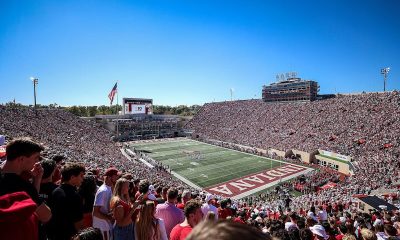
 NIL3 weeks ago
NIL3 weeks agoIndiana’s rapid ascent and its impact across college football
-

 Motorsports3 weeks ago
Motorsports3 weeks agoPohlman admits ‘there might be some spats’ as he pushes to get Kyle Busch winning again
-

 Motorsports3 weeks ago
Motorsports3 weeks agoIncreased Purses, 19 Different Tracks Highlight 2026 Great Lakes Super Sprints Schedule – Speedway Digest





























